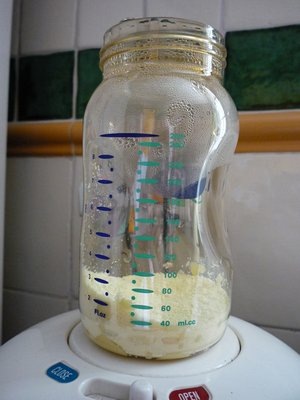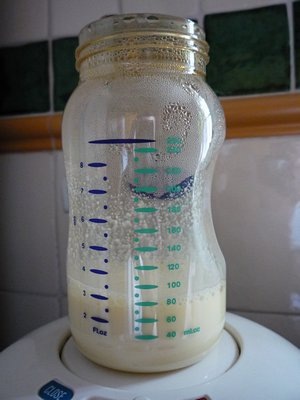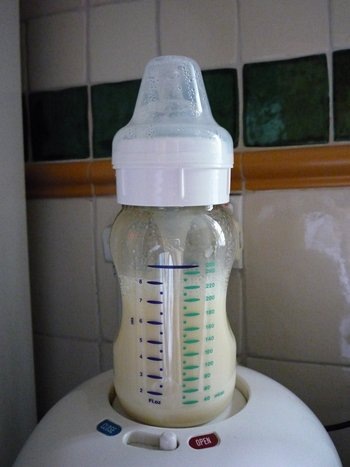Hannah has been on total formula when I stopped breastfeeding her after 3 months. I have developed my own way of preparing formula milk after starting off with the recommended method. The main reason for doing so is that the milk powder is not sterile.
The standard way of preparing formula milk is something like this: 1) pour the correct amount of warm water into bottle. 2) add x scoops of milk powder. 3) shake bottle sideways to dissolve powder and also to avoid making too much bubbles/foam.
My way of preparing formula milk:
Let’s say we use 3 scoops of milk powder and 180 ml of warm water to make milk for a feed.
1) Add x scoops of milk powder into bottle (If boiling water is added first, its hot water vapour will condense on the scoop and cause some milk powder to become wet and hence stuck to the scoop. Over time, more powder will get stuck to the scoop and make the measurement inaccurate. This means that the scoop has to be washed and dried frequently for use. I wanted to save the hassle.)


2) Add y volume of boiling water and shake well. Adding boiling water to the milk powder will help to kill most germs since the powder is not sterile. (To achieve the right temperature for warm milk that’s just nice for the baby, I use the ratio 1 part boiling water to 2 parts cooled, boiled water at room temperature) Since we need 180 ml of warm water, it would be 60 ml boiling water + 120 ml cooled, boiled water. Now, the following is slightly tricky. Since the milk powder is already in the bottle, how does one determine the volume of boiling water to add? Well, I work it backwards. For the very first time I prepare the formula milk, I would add the boiling water first and then add the powder and shake well to avoid lumps. This is where I would take note of the new volume of the mixture (e.g. 80 ml) in the bottle. So the next time when I add the powder first, I would pour boiling water until I reach the mark (i.e. 80 ml). Actually, it is a bit more complicated than this. After adding the powder, I would pour less than the required volume of boiling water and shake the bottle vigorously to dissolve the powder first. Then I would top up with boiling water to the required mark (i.e. 80 ml). I have better accuracy of milk temperature by this way.
3) Top up with z volume of cool, boiled water. To determine this amount of water I have to work it backwards again. By using the standard way of preparing milk, I would be able to tell the final volume of milk prepared as shown by the marking on the bottle. E.g. 3 scoops of milk powder + 180 ml of warm water = 200 ml of milk. Placing the bottle at eye level (I place the bottle on our oven), I would pour cooled, boiled water to the required mark (i.e. 200 ml). Voila, the milk is made!
 When I started out to prepare formula milk, I’d usually drip some milk onto my inner wrist to test its temperature before feeding Hannah. But after coming up with the above method, I have almost 100% success at obtaining the correct milk temperature. There is minimal testing of and making fine adjustments (i.e. heating up or cooling down milk) to the milk temperature. In short, I increase my efficiency. It only takes me 5 minutes to prepare a feed for Hannah. This is especially helpful when you have a bawling and hungry baby plus a new and stressed-out mother.
When I started out to prepare formula milk, I’d usually drip some milk onto my inner wrist to test its temperature before feeding Hannah. But after coming up with the above method, I have almost 100% success at obtaining the correct milk temperature. There is minimal testing of and making fine adjustments (i.e. heating up or cooling down milk) to the milk temperature. In short, I increase my efficiency. It only takes me 5 minutes to prepare a feed for Hannah. This is especially helpful when you have a bawling and hungry baby plus a new and stressed-out mother.
There is one piece of feeding accessory which I find useful but it is not absolutely essential. It is a bottle warmer. After my sister in-law Jasmine shared with me about it, I bought one too. I use it to warm up milk during each feed as the milk cools down significantly during the 30- to 60-minute feed. The milk is warmed during intervals for burping. There are also times when the baby is not ready for feeding immediately after the milk is prepared or the feeding session is interrupted by say, the baby throwing up milk. The warmer comes in handy for these situations.
In addition to preparing formula milk for every feed, I also prepare a separate bottle of warm water for Hannah. Same thing, the ratio used for preparing warm water is 1 part boiling water to 2 parts cooled, boiled water. There is no recommended amount of water to feed the baby alongside with formula. But it is highly advised to feed the baby with some water as formula milk is ‘heaty’ and more concentrated than breast milk. As for Hannah, my practice is to feed her with 20ml of water first before giving her her 2.5 scoops formula milk. A hungry baby will drink water well but may reject water if fed after the milk. I know that some mothers use barley water or even glucose solution to feed their babies when water is rejected.
Finally, I adopted a practice my confinement lady had when she was around to feed Hannah with formula. She added more water to the milk. Her rationale is to ensure that the baby has sufficient water just in case she doesn’t drink plain water well. So these days, I would throw in another 10 ml of water into the milk made for Hannah. As long as she empties the bottle each time, she would still consume the right amount of nutrients derived from the milk powder.
Whew, so much to share just on preparing formula milk! And I haven’t even touch on washing and sterilising milk bottles! Indeed, blessed are those who can breastfeed their babies totally. Er, even then, the milk bottles have to be used for feeding the baby with expressed milk when the mother is not available. And often, it is a good idea to introduce the taste of water in a bottle to the baby.
wow… x, y , z… haha… three variables one neh! =D so pro you.
You are such a super science teacher that you want to make me faint!!! Trust you to be so accurate in the science of amking a bottle of milk!
occupational hazard :P
hello! I came across ur blog when I was depressed abt not being able to breastfeed abt month ago due to low milk supply n ur old entry on confinement nanny/breastfeeding woes came up in my google search:)
Much be god’s way of consoling me…
Share quite a lot in common coz I’m a sci teacher too! Physics actually… My bb is 2 weeks shy of being 3 mths old. I hope to be able to continue partially bf her coz I feel guilty otherwise, rotting at home all day after all, n so long as she is willing to suckle.
Interesting point abt killing the germs in the forumla powder. All the x,y,z sounds terribly confusing tho. Must be becoming mentally lazy with all the long maternity leave. :)
Hi Lisa,
We have a friend by the same name too :) She’s expecting now :)
I’m amused that my entry came up on google search engine :P Wow, we have a few things in common! I gave up breastfeeding after 3 months as it was too tedious to breastfeed and then supplement with formula for every feed. In fact, my baby drank more formula than breastmilk. She could empty my breasts within like 5-10 mins and start fussing! Goes to show how pathetic my milk production was. I weaned her off breastmilk by reducing the frequency over a period of about 2-3 weeks. Felt guilty for ‘unplugging’ her too. But at around 3-4 months, babies’ immunity is more developed so she would be better off defending her little body. After she’s on total formula, I could find more time to rest (‘cos i’m doing one-man show at home). A happy mommy = a happy baby! :D
Thank God for formula milk man. Otherwise, mothers like us will feel even more guilty for not being able to give our babies a good start in life.
haha… when i saw lisa i thought “SO FAST???” last sun i was still chatting w her in church!!! LOL
Hi!
I’m running a one woman show too. :) I wouldn’t have minded continuing with breastfeeding and spplementing since her ability to suck has improved and she can now empty my breasts within 10 mins like u said. So not as tiring as compared to her earlier months.
Problem for me now is that she is starting to sleep longer thru e night, and pathetic though my milk suppy is, I am encountering e strange problem of leaking breasts as they fill up, which is making me lose sleep.
Can u share more abt ur weaning strategy? I always thought that with low supply, stopping is almost instantaneous. It takes over 2-3 weeks?
Hi hi Lisa,
Nice to hear from you again :)
Ya, my breasts also felt gorged and leaky while Hannah was sleeping through the night too. I couldn’t decide to wake up to express my milk or wait for her to wake up just in case…Later, when Hannah really slept through the night for certain, I just slept through the night as well. Need to rest well.
I was told recently by a friend that our low milk supply will pick up with time. Don’t know whether to believe her or not as mine really remained low even at 3 months. To be fair, iIt did increase over time but the increase simply couldn’t catch up with Hannah’s appetite. It’s like the race between making new vaccines to combat newly mutated viruses.
Okay, to wean Hannah off, I started by dropping 2 breastmilk feedings and fed her with formula totally for those 2 feeding sessions. I think we had 5-6 feedings then through the 24-hr cycle. The 2 feedings without breastmilk didn’t follow one after the other. There should be at least a breastmilk-cum-formula feeding in between them. I let this go on for a couple of days. After that, I drop one feeding every couple of days.
Throughout this weaning off period, I expressed my milk after the last feeding which was purposely planned to be totally on formula. After every 2 nights, I would bottle-feed Hannah with the expressed milk the following morning. I expressed my milk so that I won’t feel so gorged while sleeping through the night. Why only feed the expressed milk after 2 nights? Well, there’s more milk volume from 2 expresses than 1. I kept the expressed milk in the non-freezer compartment as it can keep up the 48 hrs there and it tasted better. Do you know that frozen breastmilk has a metallic aftertaste? Just a personal fetish, hee. :)
By expressing my milk, I could also tell that my milk supply started to drop as I decreased the frequency of breastmilk feeding. When I was finally down to just one breastmilk feed a day, my baby could tell that my milk supply was really really pathetic. There was nothing much to suck and she refused to latch on. I chose to drop my first morning feed (breastmilk-cum-formula) last as it was special to me. I see it as a way to give my baby some closeness and bonding at the start of the day.
By the time I stopped feeding Hannah with breastmilk, there was a bit of tenderness in my breast for just 1-2 days. It was hardly noticeable. And then, everything went back to normal. It was amazing. Of course, a few weeks later, my menses came :).
Hi Ling,
Tks for the detailed explanation. Yeah.. besides not being able to sleep thru the night properly due to the leaky breasts problem, my baby who’s now 3+ mths old has suddenly gotten rather cranky with her bottle feeds after being breastfed. She would at times kick and wail and push away her bottle feed after being breastfed. A preference for breastmilk? Nipple confusion? We don’t know.
Such sessions are becoming a daily occurence (at least once a day) and causing much strain to her and to the feeder. Very stressful as we worry abt whether she is getting enough hydration since it’s certain my breastmilk is definitely not enough. That means there is no routine for her as well because we never know what’s going to happen next.
I’m concerned that this gradual method of dropping feeds here and there might confuse her further so I was thinking of either going cold turkey, or ideally hanging on there til dec when my husband (also a teacher) is off his CPE duty so that I can stop breastfeeding totally and just pump every few hrs or so.
Getting very very tired indeed… :(
Hi Lisa,
You’re welcomed :)
I’m sorry to hear that your baby is starting to struggle at bottle feeding. From what I’ve gathered, it is quite normal and there definitely reasons for that. We can only guess and give various solutions a shot.
Hannah also had that problem. The teat would go into her mouth but instead of sucking she would use her tongue to play with the teat. The first thing I did was to change the brand of bottle I was using then. I thought the teat might be too hard for her. So from Avent, I switched to Bfree. The latter proved to be a good choice as it also reduced gassy tummy. She was okay after that. But after about 2 months, she started fussing again. It seemed to me that a plastic part of the bottle is giving off a strong plasticky smell after steam sterilising it many times. So I upgraded the internal ‘apparatus’ to the latest Bfree Plus design. The smell was gone and Hannah went back to normal drinking. Whew. Recently, she started fussing during certain feeds. But when I managed to place the teat right on her tongue in all her fidgeting, she would ‘latch on’ and suck by reflex :D
Besides teat compatibility, the brand of milk powder might be of question too. But it can be costly to switch brands. Hannah has been on Similac and she’s okay with it so far.
BTW, does your baby drink plain water? If you’re worried about hydration, pay attention to her lips and stools. They will give you telltale signs.
Don’t be discouraged! Things will improve with time. God will provide wisdom to those who ask of Him. :)